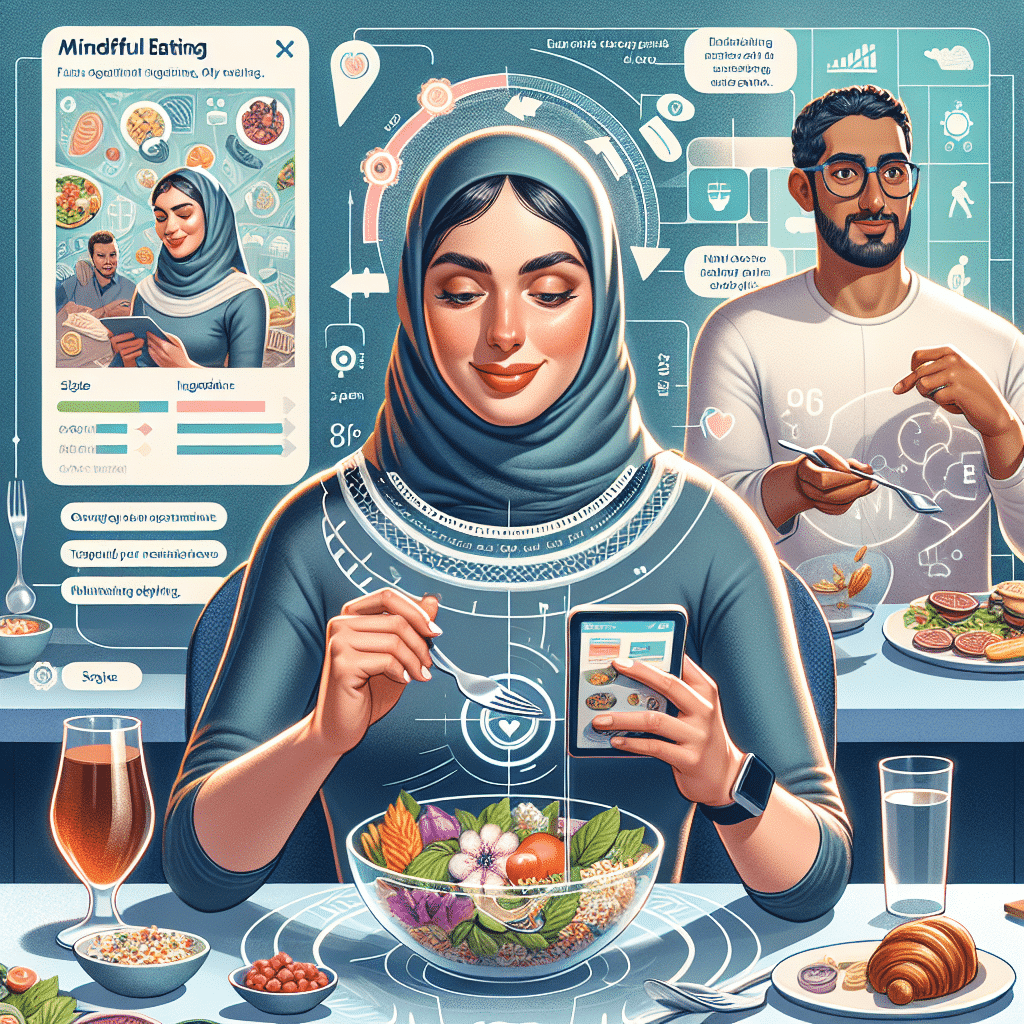
In today’s digital age, technology has become an integral part of our lives, transforming the way we do things, including the way we eat. Mindful eating, a practice that emphasizes presence and awareness during meals, has gained popularity as a way to improve our relationship with food. However, the pervasive influence of technology has both positive and negative implications for mindful eating. In this blog post, we will explore the impact of technology on mindful eating and how it shapes our eating habits. We will also discuss the challenges and benefits of incorporating technology into the practice of mindful eating.
Defining Mindful Eating
Mindful eating is a practice that involves paying attention to the present moment and being fully aware of the sensory experiences, thoughts, and emotions associated with eating. It is about cultivating a non-judgmental and compassionate attitude toward oneself and the food being consumed. Mindful eating is rooted in the principles of mindfulness, which involves intentionally directing one’s attention to the present moment without judgment. It encourages individuals to develop a greater awareness of their hunger and fullness cues, to savor each bite, and to pay attention to the taste, texture, and aroma of their food.
Mindful eating is not about strict dieting or calorie counting. It is a practice that promotes a healthy relationship with food, where one listens to their body’s needs and honors their hunger and fullness signals. By being present during meals, people can develop a deeper connection to the food they eat and cultivate a greater sense of gratitude for the nourishment it provides.
One of the main goals of mindful eating is to bring a sense of intentionality and consciousness to the act of eating, enabling individuals to make choices that align with their values and personal well-being. It encourages a shift away from mindless eating habits and external cues, such as emotional eating or eating out of boredom, and towards a more mindful and intuitive approach to nourishing the body.
Evolution of Technology
The rapid advancement of technology in recent years has significantly impacted various areas of life, including our eating habits. From smartphones and smartwatches to food tracking apps and smart kitchen appliances, technology has become deeply intertwined with our everyday lives, including the way we eat.
Technology has made it easier than ever to access food-related information and resources. With just a few taps on a smartphone, we can quickly find recipes, nutritional information, and even order food delivery. Social media platforms have also played a significant role in shaping our eating behaviors, as we are constantly exposed to images and posts related to food and eating.
Moreover, technology has enabled the development of various devices and sensors that can track different aspects of our eating habits, such as calorie intake, portion sizes, and even chewing patterns. These tools provide individuals with real-time data and feedback about their eating behaviors, allowing them to make more informed choices and monitor their progress towards their health and wellness goals.
However, the increasing reliance on technology in our eating routines also raises concerns. Research has shown that excessive screen time and constant exposure to digital distractions during mealtimes can lead to mindless eating, overeating, and a loss of connection with the sensory experience of eating. Additionally, the abundance of food-related information online can sometimes lead to confusion and the adoption of restrictive or unhealthy eating patterns.
Therefore, it is essential to find a balance between utilizing technology to support and enhance mindful eating practices while also being mindful of its potential negative influences. By using technology mindfully and intentionally, it can be a valuable tool in promoting self-awareness, nutritional education, and wellness.

Technology Influencing Eating Habits
The integration of technology into our daily lives has undeniable effects on our eating habits. Here are some ways in which technology influences our eating behaviors:
1. Food Ordering and Delivery
Technology has revolutionized the way we order and receive food. With the rise of mobile apps and online platforms, we can easily browse through menus, place orders, and have our food delivered right to our doorstep. This convenience has led to an increase in takeout and delivery habits, impacting our food choices and portion sizes.
2. Social Media Influence
Social media platforms have become a prominent part of our lives, and they have a significant impact on our eating habits. Platforms like Instagram and Pinterest are flooded with visually appealing food images and recipes, which can influence our cravings and food choices. Moreover, social media platforms also facilitate the sharing of personal food experiences and recommendations, further shaping our food preferences and habits.
3. Nutrition Tracking Apps
Technology has made it easier for individuals to track their nutritional intake and monitor their dietary goals. Various apps and wearable devices can help individuals log their meals, track macronutrients, and monitor calorie intake. These tools can provide valuable insights and encourage mindful eating habits by creating awareness about our food choices and nutritional needs.
4. Online Food Communities
The internet has brought people with similar interests together, including those who have a passion for food. Online communities and forums dedicated to food and cooking allow individuals to share recipes, tips, and experiences. These communities can foster a sense of connection and support in maintaining healthy eating habits.
5. Virtual Cooking and Nutrition Resources
The internet is a vast resource of virtual cooking and nutrition content. From cooking videos and recipe blogs to online cooking classes and virtual nutrition consultations, technology provides easy access to a wealth of information to support healthier eating habits.
While technology can have positive influences on our eating habits, it is important to be mindful of its potential negative impacts. It is essential to use technology wisely, finding a balance between utilizing its benefits for informed decision-making and maintaining a genuine connection with our food and the mindful eating experience.
Benefits of Connecting Mindful Eating with Technology
While technology can sometimes pose challenges to our eating habits, when used mindfully, it can also provide several benefits in promoting mindful eating. Here are some ways in which technology can support and enhance our mindful eating practices:
1. Increased Awareness
Mindful eating is all about being present in the moment and paying attention to our food. Technology can help us cultivate this awareness by providing tools for tracking and logging our meals. Nutrition tracking apps, for example, can help us become more conscious of our food choices and portion sizes, encouraging mindful decision-making.
2. Access to Information
Technology gives us easy access to a wealth of information about the nutritional value of different foods, recipe ideas, and cooking techniques. The internet offers a vast array of resources, such as nutrition websites, cooking apps, and online communities where we can learn and explore mindful eating practices.
3. Mindful Eating Apps
There are several apps available specifically designed to promote mindful eating. These apps provide guided meditations, mindful eating exercises, and reminders to slow down and savor the eating experience. They can serve as valuable tools in developing and maintaining a mindful eating practice.
4. Virtual Support and Accountability
Technology allows us to connect with others who share similar goals and challenges. Through online communities, social media groups, or virtual support networks, we can find encouragement, inspiration, and accountability in our mindful eating journey. Sharing our experiences and learning from others can help us stay motivated and committed to our goals.
5. Personalized Feedback
Some technology platforms offer personalized feedback and recommendations based on our eating habits. For example, wearable devices can track our eating patterns and provide insights into our calorie intake or nutritional balance. This feedback can help us make more informed choices and align our behaviors with our goals.
By leveraging the benefits of technology, we can harness its power to support and enhance our mindful eating practices. It is important to remain mindful of our usage, ensuring that technology remains a helpful tool rather than a distraction or hindrance to our mindful eating goals.
Challenges When Bringing Technology to Mindful Eating
While technology can offer many benefits in supporting mindful eating, it also presents certain challenges that need to be addressed. Here are some challenges to consider when using technology to complement mindful eating practices:
1. Distraction and Multitasking
Technology, especially smartphones, can easily become a distraction during meal times. Notifications, emails, and social media alerts can pull our attention away from the present moment and disrupt our mindful eating experience. It is important to set boundaries and create device-free zones to minimize distractions and fully engage with the act of eating.
2. Dependence on Technology
Depending too heavily on technology for mindful eating practices can undermine the essence of being fully present in the moment. Relying solely on apps, trackers, or devices to guide our mindful eating can prevent us from developing our internal cues and deepening our connection with our body’s natural signals.
3. Accuracy and Reliability
Not all technology tools related to nutrition and mindful eating are created equal. Some apps and devices may provide inaccurate or misleading information. It is important to conduct thorough research, consult reliable sources, and use technology tools that have been validated and proven to be accurate.
4. Privacy and Security
When using technology for tracking or logging our food intake, it is crucial to ensure the privacy and security of our personal data. Sharing sensitive information about our eating habits should only be done on secure platforms and with trusted resources to protect our privacy and prevent any potential misuse of our data.
5. The Balancing Act
Integrating technology into mindful eating practices requires finding the right balance. It is important not to become overly reliant on technology or let it take precedence over our own instincts and intuition. Remember that technology is a tool to support and enhance our mindful eating journey, but ultimately, we need to listen to our bodies and trust our own judgment.
By being aware of these challenges and finding ways to navigate them mindfully, we can harness the benefits of technology while maintaining the essence of our mindful eating practices.

Conclusion
Technology has become an integral part of our lives, and it can play a significant role in supporting and enhancing our mindful eating practices. By leveraging the benefits of technology, such as apps, trackers, and online resources, we can cultivate a greater sense of awareness, connection, and intentionality in our eating habits.
However, it is essential to approach the integration of technology mindfully. Recognize the potential challenges that may arise, such as distraction, dependence, accuracy, privacy, and finding the right balance. By being conscious of these challenges and making intentional choices, we can harness the power of technology while staying true to the essence of mindful eating.
Ultimately, the goal of mindful eating is to cultivate a deeper connection with our bodies, our food, and the present moment. Technology can serve as a valuable tool, but it is our own awareness, intention, and self-compassion that will guide us towards a more nourishing and fulfilling relationship with food.






